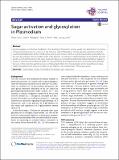Files in this item
Sugar activation and glycosylation in Plasmodium
Item metadata
| dc.contributor.author | Cova, Marta | |
| dc.contributor.author | Rodrigues, João A. | |
| dc.contributor.author | Smith, Terry K | |
| dc.contributor.author | Izquierdo, Luis | |
| dc.date.accessioned | 2015-11-03T11:40:03Z | |
| dc.date.available | 2015-11-03T11:40:03Z | |
| dc.date.issued | 2015-10-31 | |
| dc.identifier | 225285450 | |
| dc.identifier | 685fb82b-e2a5-4f90-af46-1dcb5afe6702 | |
| dc.identifier | 84946499768 | |
| dc.identifier | 000363843800001 | |
| dc.identifier.citation | Cova , M , Rodrigues , J A , Smith , T K & Izquierdo , L 2015 , ' Sugar activation and glycosylation in Plasmodium ' , Malaria Journal , vol. 14 , 427 . https://doi.org/10.1186/s12936-015-0949-z | en |
| dc.identifier.issn | 1475-2875 | |
| dc.identifier.uri | https://hdl.handle.net/10023/7733 | |
| dc.description | TKS thanks previous funding from the Wellcome Trust (093228), SUSLA and BBSRC, and current funding from MRC (MR/M020118/1) and European Community’s Seventh Framework Programme under grant agreement No. 602773 (Project KINDRED). MC, JAR and LI are members of the GlycoPar-EU consortium (FP7 funded Marie Curie Initial Training Network), Grant Agreement Number GA. 608295. | en |
| dc.description.abstract | Glycoconjugates are important mediators of host-pathogen interactions and are usually very abundant in the surface of many protozoan parasites. However, in the particular case of Plasmodium species, previous works show that glycosylphosphatidylinositol anchor modifications, and to an unknown extent, a severely truncated N-glycosylation are the only glycosylation processes taking place in the parasite. Nevertheless, a detailed analysis of the parasite genome and the recent identification of the sugar nucleotide precursors biosynthesized by Plasmodium falciparum support a picture in which several overlooked, albeit not very prominent glycosylations may be occurring during the parasite life cycle. In this work, the authors review recent developments in the characterization of the biosynthesis of glycosylation precursors in the parasite, focusing on the outline of the possible fates of these precursors. | |
| dc.format.extent | 10 | |
| dc.format.extent | 1417193 | |
| dc.language.iso | eng | |
| dc.relation.ispartof | Malaria Journal | en |
| dc.subject | Glycobiology | en |
| dc.subject | Malaria | en |
| dc.subject | Plasmodium falciparum | en |
| dc.subject | Sugar nucleotides | en |
| dc.subject | QH301 Biology | en |
| dc.subject | SDG 3 - Good Health and Well-being | en |
| dc.subject.lcc | QH301 | en |
| dc.title | Sugar activation and glycosylation in Plasmodium | en |
| dc.type | Journal article | en |
| dc.contributor.sponsor | The Wellcome Trust | en |
| dc.contributor.sponsor | Medical Research Council | en |
| dc.contributor.sponsor | European Commission | en |
| dc.contributor.institution | University of St Andrews. School of Biology | en |
| dc.contributor.institution | University of St Andrews. Biomedical Sciences Research Complex | en |
| dc.identifier.doi | 10.1186/s12936-015-0949-z | |
| dc.description.status | Peer reviewed | en |
| dc.identifier.grantnumber | 093228/Z/10/Z | en |
| dc.identifier.grantnumber | MR/M020118/1 | en |
| dc.identifier.grantnumber | 602773 | en |
This item appears in the following Collection(s)
Items in the St Andrews Research Repository are protected by copyright, with all rights reserved, unless otherwise indicated.

